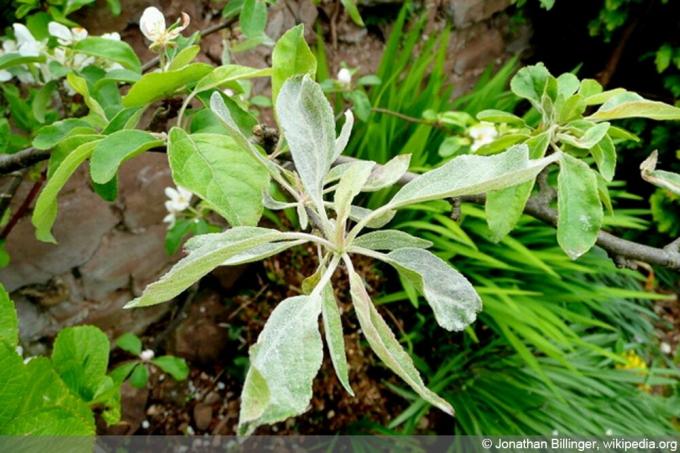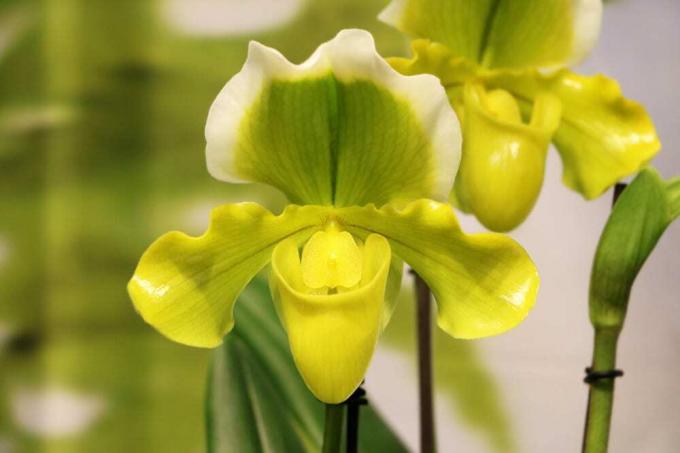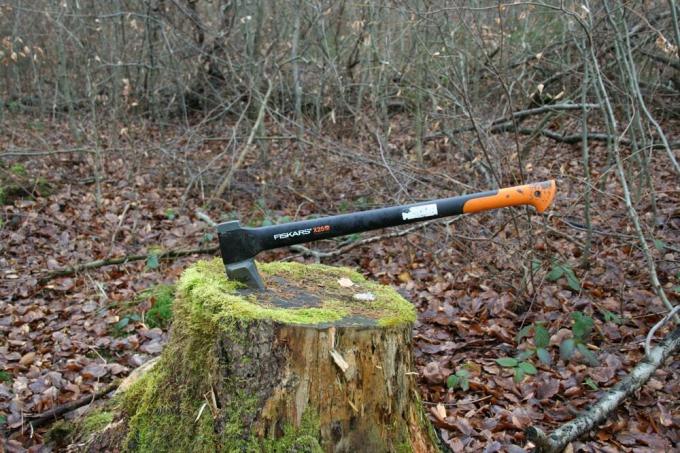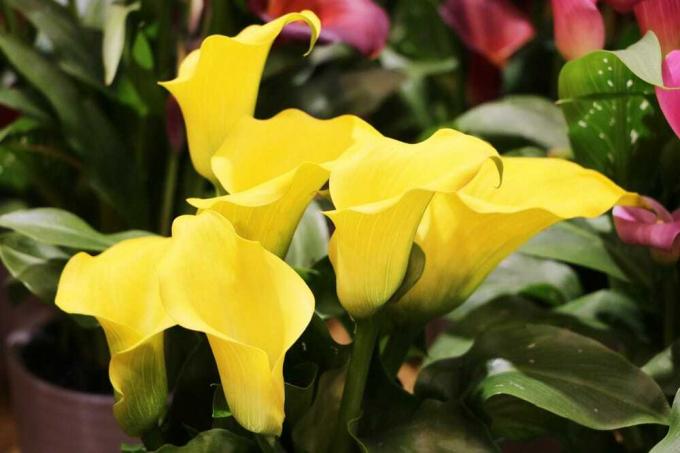

Table of contents
- Causes of mold growth
- mold in the garden
- Mold on houseplants
- mildew
- gray mold
- combat
- Prevent
- Conclusion
In nature, white mold lives everywhere on plants and their leaves. This is caused by fungi nesting on dying substances of organic origin. In healthy and still living plants, however, mold growth can lead to damage and also makes an unsightly impression. When mold spreads on houseplants, caution is advised as the mold spores spread throughout the air. In this way, the spores can cause damage to the health of residents if they are inhaled.
Causes of mold growth
When plants are infected with mold, a whitish layer forms on the leaves. Excessive humidity and waterlogging in the soil are often to blame for mold growth. In this case, the mold spores spread like a net over the soil in the garden and also attack the plant leaves. Especially during cool autumn days, when the weather is too humid, there is an increased mold infestation. If the sun then hides behind clouds all day long, the soil cannot dry sufficiently and the mold finds perfect conditions.
- Mold spores need a certain climate to spread
- Lukewarm weather with high humidity is ideal
- Prefers cloudy weather conditions
- Various types of mold appear in home gardens and flower pots
- Alternaria, Aspergillus and Penicillium are particularly common
- Dirty garden tools can lead to increased spread
mold in the garden
Mold growth in the garden to the usual extent is normal and to be expected. The mold spores nest mainly in organic substances when they die. Mold fungi make a significant contribution to a functioning ecosystem that can supply and dispose of itself. This allows the nutrients from the dead plants to migrate into the soil and ensure adequate mineralization. However, mold is not only found on dying plants and on the compost heap, but also affects healthy shoots and nests in the soil. If healthy and still young plants develop white mold on the leaves, countermeasures must be taken promptly.
- Mold occurs particularly in shady and cool, damp locations
- Plants under low-growing trees are particularly affected
- Dying plants in the neighborhood support mold growth
- Excessive mold growth can lead to the death of garden plants
- Always disinfect all garden tools with alcohol before and after use
Mold on houseplants
Mold spores feel particularly comfortable on indoor plants if they are only cultivated in the living room. Indoors there are ideal growth conditions for mold cultures. In nature, extreme temperature fluctuations and strong sunlight ensure natural control. On the other hand, mold finds the desired temperatures and conditions in the living room at home, comfortably warm and humid. In this context, excessive humidification of the potted plant plays a significant role in the further spread of mold.
- Permanently moist soil leads to mold growth on indoor plants
- Falling and rotting leaves provide perfect living conditions
- Proximity to the radiator guarantees warm conditions
- Often there is not enough ventilation
- Human exhalations increase humidity
Tip:
For people with allergies to mold and with serious illnesses, we recommend not having potted plants in living spaces.
mildew

Powdery mildew is a stubborn mold that affects both crops and ornamental plants. This mold prefers good weather conditions, with temperatures above 20° C and in combination with high humidity. New leaves in particular cannot mature properly if the drought persists and offer the fungal spores a welcome target when it rains again. The mildew is visible as a white and mealy coating on the affected areas. As a preventative measure, a sunny and airy location is crucial so that the leaves can dry quickly after every downpour. In this way, the powdery mildew fungus has little surface to attack. In addition, a nutrient-rich and high-quality soil prevents the emergence.
- Can be combated by spraying with tinctures
- A horsetail broth has proven its worth
- Garlic broth and tansy tea are also helpful
- Milk and whey also have healing properties
- Spray on a rainless and dry day
- Apply directly to the affected areas
- Repeat treatment regularly until mold disappears
gray mold
If the plant is infested with gray mold, a gray and velvety coating will cover the affected leaves. All plant species with soft leaves are particularly susceptible to this mold. As a rule, gray mold usually forms on damaged and dead plant parts. If water accumulates permanently on the leaves and cannot dry off quickly, mold growth is promoted. In addition, too much nitrogen fertilization supports the formation of gray mold.
- Avoid spraying the leaves too vigorously and frequently
- Cut off affected leaves and stems
- Treat with fungicide
- If the infestation is extremely advanced, discard the entire plant
combat
When mold grows on plant leaves, it should be removed as soon as possible. Otherwise, the mold spores can lead to health problems for the residents when it comes to indoor plants. In extreme cases, it can spread from the potted plants to the surrounding ceilings and walls. Excessive mold growth can also be harmful in the garden and lead to the death of healthy plants. It also poses a danger to playing children and frolicking pets. When the mold has spread to the leaves of the plant, the soil is usually affected as well.
- Remove moldy and already rotting leaves from household waste
- Remove rubbish from the apartment immediately
- Spores are constantly spreading through the air
- Repot the affected plant as soon as possible
- Fill the planter with new, high-quality potting soil
- Ventilate living spaces regularly and longer
- Place affected indoor plants on the windowsill in the sun
- If available, bring to the balcony for some time in warm weather
Tip:
If, after taking countermeasures, the mold on the leaves quickly reappears, it does not appear that it can be completely removed. In this case, a complete disposal of the affected plants is recommended.
Prevent
So that the plants in the garden and in the living room can enjoy a long life, the formation of mold should be prevented in the long term. Various microorganisms and fungi are naturally found in the soil, in a healthy ecosystem these regulate themselves. If, however, mistakes are made during maintenance and the site conditions are not right, mold will grow excessively. Excessive growth of mold is to be expected, especially in autumn and spring. For this reason, the plants should be checked regularly for mold infestation at this time of year. If mold grows on the leaves, they must be removed immediately.
- Water sparingly, never overwater
- Absolutely avoid waterlogging
- Create drainage, both in the garden and in the flower pot
- In this way, excess water can always run off
- Cover the drainage hole in the flower pot with a piece of pottery
- Lay a loose layer of gravel on top and cover with soil
- Allow the surface of the soil to dry out completely from time to time
- Repot indoor plants every spring
Conclusion
The occurrence of white mold in nature is a completely natural process that normally regulates itself. In the garden, however, improper site conditions and prolonged rainy days can create perfect conditions for excessive mold growth on the leaves. If this gets the upper hand, the whole plant can even die. Countermeasures must therefore be taken immediately. The rotting plant parts are to be removed directly, not on the compost heap, but in the household waste. Mold spores are extremely fine and very light, they spread through the air with a gentle breeze. Persistent waterlogging often causes mold to form on the leaves of indoor plants. In this case, reducing the number of pouring units and laying a drain will help. When using tools, care must always be taken to ensure that they are disinfected with alcohol beforehand and afterwards. This reduces the risk of transmission. A white and floury coating is an indication of powdery mildew, which can be combated by spraying on natural home remedies. If the plaque is rather gray, then it is gray mold, which is often difficult to remove completely. If the mold infestation is extremely widespread, the last resort is often to remove the entire plant.
 garden editorial
garden editorial I write about everything that interests me in my garden.
Learn more about plant care

Prick radishes: Instructions | How to increase the harvest
Pricking out is a common horticultural practice that is particularly important when growing radishes. If the plants are too close together, they cannot develop. With the right approach, separation becomes child's play.

Fertilize orchids - when, how and with what? The top 10 fertilizers
Orchids are the ideal eye-catcher for the windowsill, the balcony and in the garden. Because of the plant family's unique diversity, many gardeners wonder how fertilizing the Orchidaceae works to provide the flowers with the right nutrients.

Remove tree stump / have it milled - costs + prices of the root cutter
An unwanted tree stump can be removed in a number of ways, although using a stump grinder is usually the best way to do this. Here you can find out how this device is used and what needs to be taken into account when using this method!

Kumquat sheds leaves/flowers - which helps the kumquat tree
There are various reasons why a kumquat tree loses its leaves and flowers. In winter, leaf loss is rarely a cause for concern, but appropriate countermeasures should be taken in summer, otherwise the tree will quickly become bare. In this context, the temperature, the light and the casting units must be checked in particular.

Build your own rhizome barrier for bamboo & co – alternatives
Plants with rhizomes, i.e. roots that spread underground from which new plants grow elsewhere, can quickly spread throughout the garden bed and to the neighbor. To prevent this from happening in the first place, rhizome barriers should be used around the plant, for example the popular bamboo, which the hobby gardener can also build himself.

Repot indoor plants - instructions for popular green plants
If you also like a lot of plants in the apartment, you usually have a lot of beautiful, especially large green plants in the corners. In addition to regular watering and fertilizing, care also includes repotting, which should be done every three to four years at the latest. Repotting the plant not only gives it more space, but also fresh soil with new nutrients.

